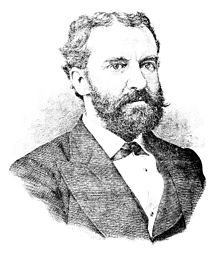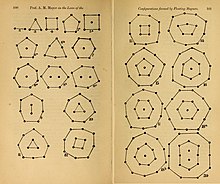Alfred M. Mayer
Alfred Marshall Mayer (born November 13, 1836 in Baltimore , Maryland , † July 13, 1897 in Maplewood , New Jersey ) was an American physicist . Although he spent most of his career at an engineering school, his work was predominantly experimental or theoretical in nature and little oriented towards commercial use.
Life
Alfred M. Mayer was the son of Charles F. Mayer , a politician ( Senator from Maryland) and lawyer. While his father wanted Alfred to become a lawyer, he was more interested in science and was eventually promoted by Joseph Henry . Mayer initially worked as a mechanic or chemical laboratory assistant in the factories in the vicinity. He developed an apparatus for producing carbonic acid and one for drawing glass.
In his early twenties, Mayer gave lectures in physics and chemistry at the University of Maryland as an assistant professor - without his own university education , while his predecessor John H. Alexander was in Europe for training purposes. Mayer received a professorship at Westminster College in Fulton , Missouri , in 1858 , where he held lectures in physics, chemistry and zoology, which were unusually experimental for the time.
In the Civil War , Mayer wanted to fight on the side of the Confederation , but had to find that his home state Maryland fell on the side of the Union . In 1863 Mayer left Maryland and began studying at the University of Paris , among others with Henri Victor Regnault , which he finished without a degree.
In 1865 Alfred Mayer took over a professorship in physics and chemistry at Pennsylvania College in Gettysburg , which in 1866 gave him a Ph.D. awarded. In 1867 he switched to a professorship for physics and astronomy at Lehigh University . Here he received for the first time sufficient experimental equipment and was able to make significant contributions to electromagnetism and astronomy. On August 7, 1869, he headed the photography department of the United States Nautical Almanac expedition (led by John Huntington Crane Coffin ) to Burlington , Iowa , to observe a solar eclipse . Mayer took much-noticed photos of the sun with an exposure time of about 0.002 seconds.
Alfred Mayer was offered a professorship at the Stevens Institute of Technology in Hoboken , New Jersey , in 1871 . In Hoboken he was again able to achieve significant experimental results and stayed there for the rest of his professional career. His experiments on the Earth's magnetic field led to his well-respected textbook The Earth, a Great Magnet . Mayer made important contributions to the physiology of hearing , especially to dissonance . Other of his monographs and his experiments dealt with light and sound . He has also written numerous journal and encyclopedia articles.
Of greater interest were his experiments with floating magnets, the arrangement of which was viewed as a model for molecular connections and various physical effects. After experiments to determine the speed of projectiles, Mayer had a phase of life between 1881 and 1889 in which he practically and theoretically dealt more with hunting and fishing than with physics. In 1883 he published as editor and co-author Sport with Gun and Rod in American Woods and Waters .
From 1890 Mayer was increasingly active again in scientific research and published, among other things, on the thermal expansion of various materials or the construction of heliostats , the physiology of vision or surface tension .
Mayer was married twice. His second wife and son survived him.
Awards (selection)
- 1869 member of the American Philosophical Society
- 1872 member of the National Academy of Sciences
- 1874 Fellow of the American Association for the Advancement of Science
- 1875 member of the American Academy of Arts and Sciences
literature
- Alfred G. Mayer , Robert S. Woodward: Alfred Marshall Mayer 1836-1897 . In: National Academy of Sciences (Ed.): Biographical Memoirs . 1916, p. 242–272 ( nasonline.org [PDF; 1.9 MB ]).
Web links
Individual evidence
- ↑ Alfred M. Mayer. In: search.amphilsoc.org. American Philosophical Society , accessed December 25, 2018 .
- ↑ Alfred Mayer. In: nasonline.org. National Academy of Sciences , accessed December 25, 2018 .
- ↑ Book of Members 1780 – present, Chapter M. (PDF; 1.1 MB) In: American Academy of Arts and Sciences (amacad.org). Accessed December 25, 2018 .
| personal data | |
|---|---|
| SURNAME | Mayer, Alfred M. |
| ALTERNATIVE NAMES | Mayer, Alfred |
| BRIEF DESCRIPTION | American physicist |
| DATE OF BIRTH | November 13, 1836 |
| PLACE OF BIRTH | Baltimore , Maryland |
| DATE OF DEATH | July 13, 1897 |
| Place of death | Maplewood , New Jersey |


